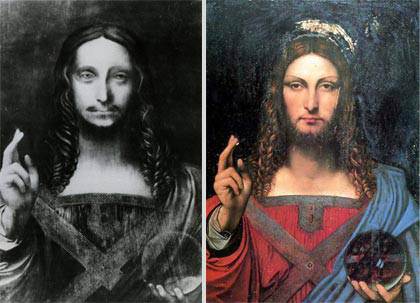
The newly attributed work (left) and the version sold in 1999
Leonardo’s ‘Salvator Mundi’: a call for skepticism Inside the ‘discovery’ of Leonardo da Vinci’s long lost ‘Salvator Mundi (Savior of the World)’ in the collection of a group of New York art dealers]]>
July 5th 2011, source: theartwolf.com
Read the latest update: July 18th 2011
It has been a week since ARTnews published the “discovery” of Leonardo da Vinci’s long lost “Salvator Mundi (Savior of the World)” in the collection of a group of New York art dealers.
According to the latest news, the work has been authenticated by a group of scholars in Europe and America, and will take part of the highly anticipated exhibition devoted to Leonardo da Vinci opening November 9th 2011 at the National Gallery of London
A call for skepticism
In 1999, another “Salvator Mundi” attributed to a follower of Leonardo da Vinci was sold at Sotheby’s for $332,500. Now, according to several sources, the owners of the newly authenticated Leonardo are asking $200 million for the work. With this in mind, it is not hard to understand that there are many interests in this attribution, and not only artistic ones.
On the last decade, there have been many claims relating to “rediscovered” Leonardos, and none of them are now considered to be authentic. Let’s remember some of them.
On October 2009, an almost worthless 19th century painting, known as “Young Girl in Profile in Renaissance Dress” or “La bella principessa”, made big news when it was attributed by some scholars to Leonardo da Vinci. A forensic art examiner claimed to have discovered a fingerprint very similar to one at Leonardo’s “Saint Jerome in the Wilderness”. The work was quickly valued at $150 million. But many well-known experts, including Klaus Albrecht Schröder from the Albertina, Everett Fahy from the Metropolitan, and art historian Fred R. Kline; have strongly rejected this attribution.
In early 2000s, a third version of Leonardo’s “Virgin of the Rocks”, known as the Cheramy version, was presented as a genuine Leonardo by some scholars, with an estimated value of at least $50 million (quite ridiculous, as a genuine third version of such a famous work could be easily sold for more than $200 million). 10 years later, its attribution is more than doubtful.
Will this “new” Leonardo be added to the list of false (or at least improbable) attributions or it will really be one of the most important artistic discoveries of the last decades? Only time will tell.
Related content
Leonardo da Vinci: life and works
Follow us on:


